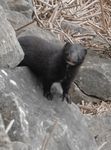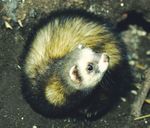A guide to identifying the small mustelids of Britain and Ireland
←
→
Page content transcription
If your browser does not render page correctly, please read the page content below
The small mustelids or weasel family
Order: Carnivora
Family: Mustelidae
The small mustelids are
characterised by their long thin
body shape, which enables them
to follow their prey down small
tunnels and burrows. However,
because of their similar body shape
they can be difficult to distinguish
from each other, especially when,
as is usually the case, they are
seen only briefly and in poor light!
Otter
Pine Marten
Mink
Photograph by Clive Craik
Polecat
For the purposes of
identification they can be
separated into two groups Stoat
based on size:
Weasel
1. Weasel and stoat
2. Pine marten, polecat, The otter, one of our larger
polecat-ferret and mink mustelids, is shown here for size
comparison only.
Cover photographs: Irish stoat by Carrie Crowley, Pine marten by Bill Cuthbert,
Polecat by Jane Parsons1. Weasel (Mustela nivalis) and stoat (Mustela erminea)
(head and body less than 30cm)
Weasels and stoats are generally much smaller than the rest of the
mustelids. The other distinguishing feature is the sharp contrast between
the reddish-brown coat colour on their back and sides and the creamy
white fur on the throat, chest and belly.
The weasel
The weasel is the smallest of the
small mustelids and the smallest
of all the carnivores. It has short
legs and a slender body (17-24cm).
The fur is chestnut brown on the
back and head with a creamy
white belly, and the division
between brown and cream is
irregular and spotted. This
irregular pattern is different
for each animal so can be used
to identify individuals. The tail
is short (3-6cm) and is a uniform
chestnut brown colour with no
black tip.
Photograph by Frank Greenaway
Although there is quite a difference in size between weasels and stoats, the
black tip to the stoat’s tail (which is always present, even in white winter
coat) is usually the only visible difference when an animal is seen at a
distance. If seen moving, then the weasel’s gait is often quicker, flatter and
less bounding than that of the stoat. Weasels are absent from Ireland.The stoat
The stoat is slightly larger
(20-30cm) than the weasel and
has a longer tail (7-12cm) with a
distinctive black tip. It is a sandy
brown colour on the back and
head with a cream belly, and the
division between brown and cream
fur is straight. If live animals
are seen, the black tail tip is a
key identifying feature, and the
stoat’s gait is a characteristically
arched-back bounding movement.
Photograph by Frank Greenaway
The Irish stoat
The Irish stoat (Mustela erminea
hibernica) is a recognised
sub-species. The division between
upper and lower coat colour in
Irish stoat can be irregular, as
in the British weasel.
Photograph by Carrie Crowley
In Scotland and the north of England and Wales, the stoat turns white
in winter (apart from the black tail tip); in Ireland and southern
England the winter coat stays brown. Elsewhere in England and Wales,
stoats with piebald or mottled winter coats are often seen.2. Pine marten (Martes martes), polecat (Mustela putorius),
polecat-ferret and mink (Mustela vison)
(head and body 30-50cm)
Pine marten, polecat, polecat-ferret and mink all have long sinuous bodies
but are much larger and heavier than stoats. They are also more strictly
nocturnal, making it difficult to see and identify live animals with certainty.
The pine marten
The pine marten is a chestnut
brown, cat-sized animal with large
rounded ears fringed with pale fur,
a creamy yellow or orange chest
and throat patch and a long
bushy tail. It has longer legs and
tail than either mink or polecat,
and its gait on the ground is
characteristically loping or
bounding.
This is the mustelid species
most likely to be seen in trees,
although pine marten also spend
much of their time on the ground.
Photograph by Frank Greenaway
The large, creamy yellow throat patch is diagnostic; however, smaller and
usually whiter patches are found on the throat of some mink and
polecat-ferrets. Mink, stoat and weasel can also climb trees but are not
normally arboreal, whereas pine marten are agile climbers. When seen in
the trees a pine marten may be confused with red or grey squirrel, but it has
a longer body and tail, darker coat and is much larger.The polecat
The polecat has dark guard hairs
with creamy underfur over most
of its body, a dark facial mask,
white fur on the muzzle and white
ear margins; this colouration
distinguishes it from the similar
sized American mink, which
is uniformly dark. Polecats can,
however, look very similar to feral
ferrets, some of which are bred to
look like polecats, and to
polecat-ferret hybrids. Photograph by Johnny Birks
The dark fur on the face of a polecat always extends to the nose, and
the pale cheek patches and possible frontal band contrast with the dark
facial mask. There is not usually a pale throat patch but if there is it is
small (less than 50mm long). Polecats have dark fur on their paws and
dark guard hairs over the body, so even though the creamy underfur shows
through on the flanks there are no white hairs present on the body.
The polecat is absent from Ireland.
The polecat-ferret
The polecat-ferret can appear
very similar to the polecat, but
the presence of one or more of
the following characteristics can
be used to distinguish them to
some extent. However, dark
polecat-ferret hybrids can be
difficult to separate from polecats
in the field. In polecat-ferrets the
dark fur on the face often does not
reach the nose, and the pale cheek
patches and frontal band are
Photograph by Johnny Birksextensive, contrasting poorly with the darker facial mask which may be
absent. There may be a large pale throat patch (50mm or more in length),
the paws can be pale, with one or more white paws; and there may be white
guard hairs scattered over the body, especially on the hind quarters and tail.
Feral ferrets are present in Ireland.
Feral ferrets can range in colour from pure albino to dark animals
almost indistinguishable from wild polecats, but the overall colour is
usually pale and, in particular, the white on the face is more extensive.
The American mink
The American mink is a non-native
species that has become widely
established throughout Britain and
Ireland. Mink are a uniform dark
chocolate brown which may appear
almost black at times. There is
often a white chin patch present
and sometimes white patches are
also present on the chest, belly
and groin. The tail is slightly bushy
and approximately half the body
length.
Mink are semi-aquatic and usually
found near water, where they may
be mistaken for otters. However,
mink are substantially smaller than
otters, with a much thinner and
shorter tail.
Photograph by Henry SchofieldFurther reading For more information about small mustelids : Aubry, K.B., Zielinski, W.J., Raphael, M.G., Proulx, G. & Buskirk, S.W. eds. (2012) Biology and Conservation of Martens, Sables, and Fishers: A New Synthesis. New York: Cornell University Press. Birks, J. (2002) The Pine Marten. London: The Mammal Society. Corbet, G.B. & Southern, H.N. (1991) The Handbook of British Mammals. Oxford: Blackwell Scientific Publications. Dunstone, N. (1993) The Mink. London: T. & A.D. Poyser. Harris, S. & McDonald, R. (2006) Stoats and Weasels. London: The Mammal Society. King, C.M. & Powell, R.A. (2006) The Natural History of Weasels and Stoats: Ecology, Behavior, and Management. Oxford: Oxford University Press. Sleeman, P. (1989) Stoats and Weasels, Polecats and Martens. London: Whittet Books. The Vincent Wildlife Trust (2002) Polecats and ferrets: how to tell them apart. Ledbury: The Vincent Wildlife Trust. The Vincent Wildlife Trust (2004) The Pine Marten. Ledbury: The Vincent Wildlife Trust. The Vincent Wildlife Trust (2008) The Polecat. Ledbury: The Vincent Wildlife Trust. Part-funded by the European Regional Development Fund www.vwt.org.uk enquiries@vwt.org.uk The Vincent Wildlife Trust 2013, Charity Nos.1112100 (England), SC043066 (Scotland) and DCHY00019 (Ireland) Company Registered in England No.05598716 3 & 4 Bronsil Courtyard, Eastnor, Ledbury, Herefordshire HR8 1EP Tel: 01531 636441
You can also read



























































